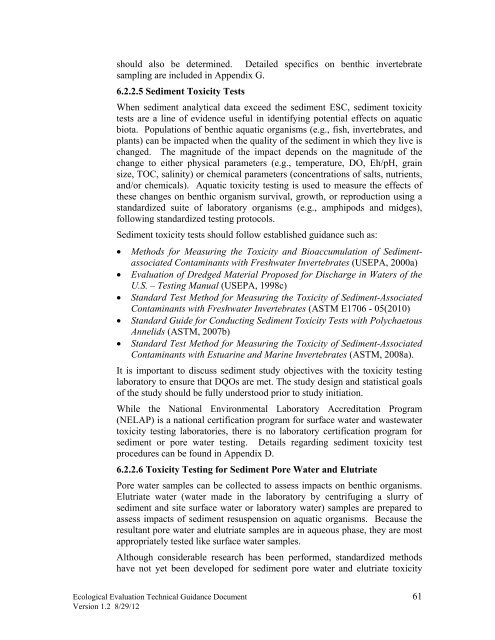Ecological Evaluation Technical Guidance - State of New Jersey
Ecological Evaluation Technical Guidance - State of New Jersey
Ecological Evaluation Technical Guidance - State of New Jersey
- No tags were found...
Create successful ePaper yourself
Turn your PDF publications into a flip-book with our unique Google optimized e-Paper software.
should also be determined. Detailed specifics on benthic invertebratesampling are included in Appendix G.6.2.2.5 Sediment Toxicity TestsWhen sediment analytical data exceed the sediment ESC, sediment toxicitytests are a line <strong>of</strong> evidence useful in identifying potential effects on aquaticbiota. Populations <strong>of</strong> benthic aquatic organisms (e.g., fish, invertebrates, andplants) can be impacted when the quality <strong>of</strong> the sediment in which they live ischanged. The magnitude <strong>of</strong> the impact depends on the magnitude <strong>of</strong> thechange to either physical parameters (e.g., temperature, DO, Eh/pH, grainsize, TOC, salinity) or chemical parameters (concentrations <strong>of</strong> salts, nutrients,and/or chemicals). Aquatic toxicity testing is used to measure the effects <strong>of</strong>these changes on benthic organism survival, growth, or reproduction using astandardized suite <strong>of</strong> laboratory organisms (e.g., amphipods and midges),following standardized testing protocols.Sediment toxicity tests should follow established guidance such as:Methods for Measuring the Toxicity and Bioaccumulation <strong>of</strong> SedimentassociatedContaminants with Freshwater Invertebrates (USEPA, 2000a)<strong>Evaluation</strong> <strong>of</strong> Dredged Material Proposed for Discharge in Waters <strong>of</strong> theU.S. – Testing Manual (USEPA, 1998c)Standard Test Method for Measuring the Toxicity <strong>of</strong> Sediment-AssociatedContaminants with Freshwater Invertebrates (ASTM E1706 - 05(2010)Standard Guide for Conducting Sediment Toxicity Tests with PolychaetousAnnelids (ASTM, 2007b)Standard Test Method for Measuring the Toxicity <strong>of</strong> Sediment-AssociatedContaminants with Estuarine and Marine Invertebrates (ASTM, 2008a).It is important to discuss sediment study objectives with the toxicity testinglaboratory to ensure that DQOs are met. The study design and statistical goals<strong>of</strong> the study should be fully understood prior to study initiation.While the National Environmental Laboratory Accreditation Program(NELAP) is a national certification program for surface water and wastewatertoxicity testing laboratories, there is no laboratory certification program forsediment or pore water testing. Details regarding sediment toxicity testprocedures can be found in Appendix D.6.2.2.6 Toxicity Testing for Sediment Pore Water and ElutriatePore water samples can be collected to assess impacts on benthic organisms.Elutriate water (water made in the laboratory by centrifuging a slurry <strong>of</strong>sediment and site surface water or laboratory water) samples are prepared toassess impacts <strong>of</strong> sediment resuspension on aquatic organisms. Because theresultant pore water and elutriate samples are in aqueous phase, they are mostappropriately tested like surface water samples.Although considerable research has been performed, standardized methodshave not yet been developed for sediment pore water and elutriate toxicity<strong>Ecological</strong> <strong>Evaluation</strong> <strong>Technical</strong> <strong>Guidance</strong> Document 61Version 1.2 8/29/12
















